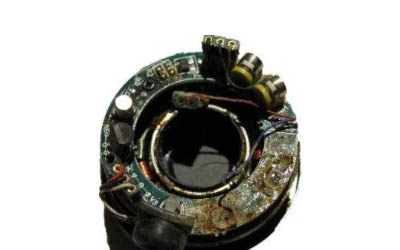Protecting circuit boards from the effects of corrosives like H2S and Chlorine.
When selecting camera equipment for industrial purposes, everyone understands the importance of selecting a housing that will protect the camera from corrosives in the plant atmosphere. It is readily accepted that stainless steel is the go-to housing material for corrosion resistance. How then did the camera lens at the right corrode? It was in a stainless-steel housing manufactured by a very popular security company. The housing came with an NEMA4X/IP66 rating. Yet the camera inside was eaten alive with corrosion.
The answer lies in the seals. A NEMA4X/IP66 rating, while a great rating for general outdoor use, is not an air-tight seal. If this camera had been viewing a parking lot, it would still be alive today. However, it was placed into service watching batch digesters and therefore exposed to H2S. The housing of the camera appeared to be in fine shape, but when opened revealed a camera destroyed by corrosion. This issue is a common camera problem in industry.
An NEMA4X/IP66 rating, while impervious to water, is not an air or gas tight seal. Cameras when deployed outside often “breath”. Breathing is a phenomenon that occurs when a camera is exposed to varying temperatures and barometric pressures throughout the day. As the temperature heats up, air inside the housing expands and is pushed out through the seal. At night the air inside the camera cools and shrinks causing air to be drawn into the housing. This “breathing” causes an exchange of gases within the camera over time. If the outside air has hydrogen sulfide (H2S) or other corrosive gases the camera will eventually be eaten alive, even thought the housing appears fine on the outside.
Bass Electronics’ solution is an air-tight seal on its stainless-steel housing. Make the camera hold its breath!!




